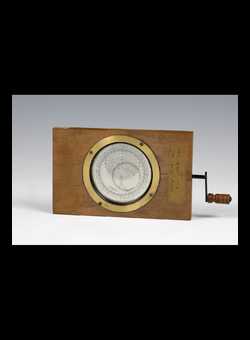| Date | 1929 |
| Maker | W. Watson & Sons |
| Place | London |
| Material | Wood |
| Inventory no. | 21423 |
| Acquisition | Presented by W. Watson & Sons in 1929 |
Entertaining visual effects were introduced into popular magic lantern shows in the nineteenth century through setting layers of glass on top of each other. One layer would be fixed, while one or two others could either slide or rotate, with the rotation generally effected by rack and pinion and a turning handle. When the layers were superimposed by projection, audiences were surprised or even startled to see movement and change on the screen.
Here exactly the same technique is applied to an educational slide demonstrating the astrolabe. It was developed from the 'Oxford Astrolabe' which was designed in conjunction with the Museum in 1925 (see inventory no. 41427) by the Oxford professor of engineering science C. F. Jenkin. The astrolabe is ideally suited to this treatment, as the rete rotates over the stationary latitude plate, and the fretted plate of the traditional rete is really an attempt to make a brass plate as transparent as possible.
View all
images for this astrolabe
View
detailed provenance for this astrolabe
Rete
The rete contains 25 stars.
The rete contains 3 scales of the
following types: Right ascension; Ecliptic; Calendar.
More information
Plates
There is one plate for latitude 51°0' . More information

